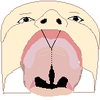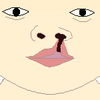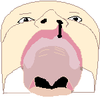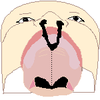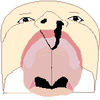Cleft lip and palate
| Classification according to ICD-10 | |
|---|---|
| Q35 | Cleft palate |
| Q36 | Cleft lip |
| Q37 | Cleft palate with cleft lip |
| ICD-10 online (WHO version 2019) | |
The cleft lip and palate ( LKGS clefts , Latin Cheilognathopalatoschisis, Greek χείλος cheĩlos lip, γνάθος gnáthos jaw; σχίζω schisis cleft; Latin palatum palate) form a group of congenital malformations with an incidence of 1: 500 are among the most common congenital malformations in humans. What they have in common is that parts of the mouth area do not develop normally during embryonic development .
Emergence
During embryogenesis in early pregnancy, parts of the face develop separately and later grow together. At the beginning of the first branchial arch, among other things, two nasal bulges and two maxillary bulges develop on both sides of the embryo. Between the 5th and 7th week of pregnancy, the anterior parts of the left and right nasal bulges fuse together and form the intermaxillary segment. This later becomes the middle part of the upper lip ( philtrum ) and the middle part of the upper jaw with the four incisors. During further development, the left and right maxillary bulges grow together with the already fused nasal bulges. From the maxillary bulges arise the left and right parts of the upper lip on both sides of the philtrum and the left and right parts of the upper jaw on both sides of the incisors . If this fusion process does not take place completely or not at all or if the tissue tears open, it results in a cleft lip or jaw. The disorder can affect the left, the right or both seams and leads to one-sided or two-sided gaps. Depending on when the disorder occurs and how severe it is, only part of the upper lip (lip notch), the upper lip alone (cleft lip) or the upper lip together with the upper jaw (cleft lip and jaw) is affected.
Later, between the tenth and twelfth weeks of pregnancy, when the fetus is approximately 75 mm, the palatal processes of the left and right maxillary bulges fuse. For them, the hard and the soft arise palate with the uvula ( uvula ). The palatal processes grow together with the anterior intermaxillary segment. The common point of union is the anterior palatal opening (foramen incisivum). The front part ossifies and forms the hard palate (palatum durum). The soft palate (soft palate or velum) and the uvula arise from the posterior sections . A disruption in this union process results in a cleft palate or soft palate.
The cleft lip and cleft palate are two separate developmental disorders, with the cleft palate often occurring together with the cleft lip and palate.
term
The origin of the name of the cleft lip as a harelip (lat. Labium leporinum; German "rabbit lip") or the cleft palate as a wolf's throat (lat. Rictus lupinus) has not been clearly established. In the German-language medical literature, the term “hassennscharte” can be reliably identified for the first time in 1460 by Heinrich von Pfalzpaint . Possibly the term "harelip" comes from the fact that the face of the rabbit is marked by a Y-shaped crevice from the upper lip to the nostrils. Why the hare was chosen, even though other animals also have such a split upper lip, is unknown. It may be due to superstition. The equivalent “harelip” can also be found in the Anglo-American region and the term “Tu Que” (rabbit lip) in Asia.
root cause
Various causes of cleft lip and palate are listed. A combination of hereditary and external factors (multifactorial inheritance) is mainly assumed:
- There are endogenous, genetic causes ( hereditary disease ): If a family member has already been affected by a crevice, the probability of it occurring in offspring is increased. The inheritance is not yet well understood; several genes seem to be involved ( polygeny ). See below: Risk to more children
- There are exogenous causes that disrupt embryonic development:
- A lack of folic acid or an overdose of vitamins A (retinoids) and E lead to an increased risk of malformations of the neural tube ; a connection with the formation of clefts in the face (which do not originate from the neural tube) cannot be proven, contrary to many opinions to the contrary. Nevertheless, folic acid administration is urgently recommended due to the prevention of spina bifida . Since pregnancy is often only noticed after the undesirable development has already taken place, folic acid should be started after consultation with the gynecologist even if you are planning to have children, but at the latest when the pregnancy is determined. In addition, studies indicate that taking multivitamin preparations in early pregnancy can slightly but significantly reduce the risk; however, it is unclear whether these results can be explained by other lifestyle factors.
- Maternal illness during pregnancy, e.g. B. Rubella .
- Hydantoin intake (anti-epileptic)
Gap shapes
Depending on when the developmental disorder occurred during pregnancy and how severe it was, different types of clefts occur:
Cleft formations in the so-called primary palate:
- Lip notch: Part of the upper lip (lip red and lip white) is affected. The gap does not extend to the nasal entrance.
- Cleft lip: (Cheiloschisis) opening in the upper lip between the mouth and nose. The gap in the upper lip extends from the red lip to the nostril. The separation point is along the edge of the philtrum . With bilateral crevices, the central segment of the upper lip is isolated.
- Cleft lip and jaw: (Cheilognathoschisis) The lip and the tooth-bearing part of the upper jaw are affected. The gap extends along the edge of the philtrum in the upper lip and along the lateral incisor of the upper jaw.
Cleft formations that (also) affect the secondary palate:
- Cleft lip and palate: combination of cleft lip and cleft palate
- Cleft palate: In the lowest degree of severity, only a cleft appears in the uvula ( uvula bifida ). However, there may be a gap in the soft palate (celestial cleft) or complete separation of the soft and hard palates. The mouth and nose are then not separated from each other.
Gaps can occur on one side (unilateral) or on both sides (bilateral). The left side is more commonly affected, although the reason for this is unclear. The clefts either begin at the lip and progress backwards (lip notch ⇒ cleft lip ⇒ cleft lip and jaw) or they begin at the back of the uvula and progress forward (uvula cleft (split uvula) ⇒ uvula cleft, soft palate ⇒ uvula cleft, soft palate, hard palate ).
In the cleft palate, there are hidden clefts (submucosal cleft palates). Although the muscles of the soft palate, which are necessary for normal speech development and ear ventilation, are split, the intact mucous membrane above hides the split.
In the International Statistical Classification of Diseases and Related Health Problems (ICD-10) of the World Health Organization , in Chapter XVII Congenital Malformations, Deformities and Chromosomal Anomalies in Block Q35-Q37 the cleft lip, jaw and palate are classified:
Note on the LAHS code: The letters indicate the anatomical part concerned:
- L = cleft lip
- A = cleft jaw (alveolus)
- H = cleft palate
- S = sail column
Anatomical parts that are not affected are represented by a minus sign. The left part of the code indicates the right half of the face and vice versa.
If a crevice appears together with other developmental disorders, it is usually part of a syndrome : e.g. B. Microdeletion syndrome 22q11 (formerly catch-22 or velocardiofacial syndrome), Patau syndrome ( trisomy 13 ), Edward syndrome ( trisomy 18 ), Cri du chat syndrome , Van der Woude syndrome .
Frequency of occurrence
Cleft lip, jaw and palate occur more frequently in families in which one family member already has a cleft. The probability of a further occurrence depends on the type, the severity, the number of people affected in the family and the degree of relationship . Cleft lip and palate (cleft lip and palate) are among the most common congenital malformations in humans with an incidence of 1: 500. Approximately 15% of all malformations are cleft lip and palate.
- With healthy parents and one affected child, the risk for the next child is around 4–6%.
- With healthy parents and already two affected children, the risk for the next child is around 9%.
- In the case of an affected parent, the risk for the first child is around 3%, in the case of an affected child for the next child, 15–17%.
- If both parents are affected, the risk to the child may be over 35%, which is still below the risk of recurrence for a disease inherited according to Mendel's rules.
From a large number of family tree analyzes, the interdisciplinary center for cleft lip, palate and palate at the University Hospital Würzburg estimated the numbers for genetic recurrence risks as follows:
| Affected | Recurrence risk for: | % |
|---|---|---|
| father | son | 5 |
| daughter | 2 | |
| mother | son | 7th |
| daughter | 1 | |
| Brothers | Brothers | 6th |
| sister | 3 | |
| sister | Brothers | 7th |
| sister | 4th | |
| Both parents | more children | 24 |
| Mother and 1 child | more children | 10 |
| Mother and 2 children | more children | 18th |
| Father and 1 child | more children | 9 |
| Father and 2 children | more children | 18th |
| 2 children | more children | 9 |
| 2nd degree relatives (e.g. aunt, uncle, grandparents) |
any family member | 1 |
| 3rd degree relatives (e.g. cousin) |
any family member | 0.5 |
There are geographical and ethnic differences in appearance. Fissures are more common in the native populations of Australia, the Americas, Canada, India and in the population of Asian descent. The fewest columns are found in the African population. The European population is in the middle.
The EUROCAT Congenital Anomalies and Public Health report contains data from Europe:
| EUROCAT European Surveillance of Congenital Anomalies | 1996-2001 | ||
|---|---|---|---|
| key | designation | Frequency per 10,000 |
1 of x born |
| Q36 + Q37 | Cleft lip with / without cleft palate | 9.11 per 10,000 | 1 of 1098 |
| Q35 | Cleft palate | 5.84 per 10,000 | 1 of 1712 |
| Q35 + Q36 + Q37 | all columns | 14.95 per 10,000 | 1 of 669 |
The World Health Organization states the following frequencies:
| WHO IDCFA International Database of Craniofacial Anomalies | 2001 - 2002 - (2003) | ||
|---|---|---|---|
| key | designation | Frequency per 10,000 |
1 of x born |
| Q36 | Cleft lip without cleft palate | 3.7 per 10,000 | 1 of 2702 |
| Q37 | Cleft lip with cleft palate | 8.0 per 10,000 | 1 of 1250 |
| Q36 + Q37 | Cleft lip with / without cleft palate | 11.8 per 10,000 | 1 of 847 |
| Q35 | Cleft palate | 4.9 per 10,000 | 1 of 2041 |
| Q35 + Q36 + Q37 | all columns | 16.7 per 10,000 | 1 of 599 |
The Pierre Robin sequence is included in the WHO figures .
With cleft lip and jaw, boys are more often affected than girls. The isolated clefts of the palate are more common in girls.
| WHO IDCFA International Database of Craniofacial Anomalies | 2001– 2002 - (2003) | |
|---|---|---|
| key | designation | Boys / girls ratio |
| Q36 + Q37 | Cleft lip with / without cleft palate | 1.56 |
| Q35 | Cleft palate | 0.75 |
The columns appear more often on the left than on the right. About 15% are double sided columns.
Implications and problems
An isolated cleft lip causes hardly any problems preoperatively, and food intake is not disturbed. After unification of the lip ring muscle , the labial sounds can still cause problems, but this can be remedied through speech therapy training.
A complete cleft lip and palate or an isolated cleft palate can have multiple effects:
- Breathing difficulties: In the case of one-sided cleft lip and palate, one nostril is often flattened, the nasal septum curved and nasal breathing may be impeded.
- Problems with feeding in newborns, sucking is difficult. With cleft palates, food can get into the nasal cavity. The Haberman Feeder makes oral feeding easier. Breastfeeding a child with a cleft palate is particularly difficult and often has to be supported by special aids. It is normal to spend more time, a palate plate may make it easier to eat.
- Speech problems because the balance between the nasal and oral resonance spaces can be disturbed. The closure of the soft palate to the posterior wall of the pharynx and the side walls of the pharynx may be incomplete even after the palate has been operated on. The result is a hypernasal vocal sound, vowels are pronounced with too much involvement of the nasal resonance space ( nasal passages / hypernasality ). In the formation of sounds / articulation, the plosives (p / b, t / d, k / g) and the fricatives (f / s / sch) are often spoken in a different way (mostly shifted back to the pharynx or larynx).
- Ear, nose and throat disorders: A cleft palate affects the middle ear ventilation ( Eustachian tube ) in many patients . Effusions, ear infections, cholesteatomas and speech development delays due to a negative hearing balance can result.
- If the upper jaw is affected, teeth may be missing or misaligned teeth. Scars after operations and the muscular imbalance in the mouth before operations can also cause misalignment of the teeth, even if the jaw itself is not affected by the gap formation.
- If there is a lack of acceptance by the environment (for example, teasing from other children because of a speech impairment or scars on the face), psychological problems can result.
treatment
The treatment is carried out by an interdisciplinary team in the cleavage centers, which includes representatives from paediatrics , oral and maxillofacial surgery , orthodontics , ear, nose and throat medicine , phoniatrics and pediatric audiology , speech therapy and breastfeeding and nutritional advice.
- In the case of cleft palates, the nasal cavity is separated from the oral cavity in the first few days of life by a removable palatal plate, an obturator . The term "drinking plate" is misleading because the palate plate is primarily intended to control the growth of the split jaw segments, enable a physiological position of the tongue and establish nasal breathing. As a side effect, it also offers an abutment for the teat or nipple and can thus facilitate food intake. However, it does not allow a suction vacuum to be built up.
- Close monitoring of hearing; Insertion of ventilation tubes if necessary to ensure ventilation of the middle ear and prevent infections.
- Primary operations: closure of the lip, soft palate and hard palate in several steps (multi-stage treatment concept) or in a complete operation (one-step procedure, "Basel concept"). The lip is usually operated on between three days and six months of age. With regard to the time of the operation of the palate (hard palate and soft palate), there are different views in the cleft centers. On the one hand, the palate should be closed as early as possible to enable normal language acquisition, and on the other hand, the operation should be carried out as late as possible in order to disrupt the growth process of the jaw as little as possible through the operation scars. The soft palate is operated on at three to twelve months depending on the cleft center, the hard palate at 6 to 18 months, depending on the center. In the case of double-sided crevices, a nasal bridge (columellaplasty) is often necessary.
- Secondary operations: If the jaw is affected, a so-called cleft osteoplasty may be necessary between the ages of six and ten years. Bone material ( cancellous bone ) from the iliac crest is introduced into the jawbone in order to give the permanent teeth more stability. After the growth is complete, the bony part of the nose can be finally straightened.
- Speech-supporting operations: since the soft palate is often not fully functional even after the operative union, disturbances of the nasopharyngeal closure can occur ( velopharyngeal insufficiency ). Then it can make sense to support the function of the sail with a surgical procedure (velopharyngoplasty, levator support plastic). After the operation has created more favorable anatomical conditions, speech therapy is necessary.
- Treatment of misaligned teeth (orthodontics)
- Orofacial regulation therapy according to Castillo Morales
- Improvement of the aesthetics (asymmetry of the nose, nose shape, lip shape, scars)
- Speech therapy ( speech therapy )
- Early intervention for the treatment or prevention of psycho-social problems
In the cleavage centers, patients (and their legal guardians ) can be advised on the further treatment of the cleft by representatives of all disciplines involved (pediatrics, maxillofacial surgery, orthodontics, ENT medicine / pedaudiology, speech therapy, breastfeeding and nutrition advice ) in the regular consultation hours .
Mental care
The lengthy and complicated treatment during childhood and adolescence also has psychological consequences. Increasingly, these children and their parents should look to their mental health by seeking psychological support throughout the therapeutic follow-up system from an early age as recommended by the American Cleft Palate Craniofacial Association . Parents can also seek advice in self-help groups and find help and support.
In the context of syndromes
Cleft lip and palate can occur in the following diseases:
- Atelosteogenesis
- Goldenhar Syndrome
- Mandibulo-Facial Dysostosis-Microcephaly Syndrome
- Multiple pterygium syndrome
- Pierre Robin sequence
- Reardon Hall Slaney Syndrome
- Spondyloepiphyseal dysplasia
- Diamond Blackfan Syndrome
- Hydroletalus Syndrome
literature
- Samuel Berkowitz: The Cleft Palate Story . Quintessence Pub Co, 1994, ISBN 0-86715-259-1 .
- Kirsten Caspers: The other smile - babies with cleft lip and palate . Zuckschwerdt, 2008, ISBN 3-88603-936-6 .
- Klaus Honigmann: Cleft lip and palate . Huber, Bern 1998, ISBN 3-456-82833-0 .
- Hope Charkins: Children with Facial Difference . Woodbine House, 1996, ISBN 0-933149-61-1 .
- Kurt Kallenbach (ed.): Children with special needs. Selected clinical pictures and forms of disability . Wissenschaftsverlag Spiess, 1999, ISBN 3-89166-208-4 .
- Regina Masaracchia: Split feelings. Cleft Lip, Jaw, and Palate: A Parent's Guide . Oesch Verlag, 2005, ISBN 3-0350-3007-3 .
- Sandra Neumann: LKGS columns. A guide for parents . Schulz-Kirchner, 2002, ISBN 3-8248-0365-8 .
- Thomas Uhlemann: Stigma and normality. Children and adolescents with cleft lip and palate . Vandenhoeck and Ruprecht, 2000, ISBN 3-525-45723-5 .
- Ulrike Wohlleben: The intelligibility development of children with cleft lip and palate . Schulz-Kirchner, 2004, ISBN 3-8248-0376-3 .
- Rudolf Probst, Gerhard Grevers, Heinrich Iro: Ear, nose and throat medicine . Georg Thieme Verlag, Stuttgart (2000), ISBN 3-13-119031-0 , pp. 78-79.
- N. Schwenzer, M. Ehrenfeld: Dental / Oral / Maxillofacial Medicine , Volume 2, Special Surgery . Georg Thieme Verlag, Stuttgart (2002), ISBN 3-13-593503-5
- Regina Keindl: Accompanying malformations in children with cleft lip and palate. (PDF; 1.75 MB) Dissertation, including pictures of embryonic development; Technical University of Munich, 2004
Web links
- German interdisciplinary working group for cleft lip and palate / craniofacial anomalies
- Information brochure on cleft lip and palate (PDF)
- Marian Grosser: Cleft lip and palate . In: NetDoktor.de, November 19, 2016
Individual evidence
- ↑ a b Pausch, Wirtz and Hemprich: Zoomorphological terms for the designation of facial cleft formations . In: Ärzteblatt Sachsen . 01/2012. Pp. 28-30.
- ^ J. Little et al .: Folate and Clefts of the Lip and Palate - a UK-based case-control study. Part I and II. In: The Cleft Palate-Craniofacial Journal. Volume 45, 2008, pp. 428-438
- ↑ a b C.Y. Johnson, J, Little: Folate intake, markers of folate status and oral clefts: is the evidence converging? , International Journal of Epidemiology, Volume 37, No. 5, pp. 1041-1058, October 2008, PMID 18583393 , DOI 10.1093 / ije / dyn098.
- ↑ RL Badovinac et al .: Folic acid-containing supplement consumption during pregnancy and risk for oral clefts: A meta-analysis. In: Birth Defects Research Part A - Clinical and Molecular Teratology . Volume 79, No. 1, 2007, pp. 8-15; YI Goh et al .: Prenatal multivitamin supplementation and rates of congenital anomalies: a meta-analysis. In: Journal of Obstetrics and Gynaecology Canada. Volume 28, No. 8, 2006, pp. 680-689; AJ Wilcox et al .: Folic acid supplements and risk of facial clefts: national population based case-control study. In: BMJ. Volume 3, 2007, pp. 334-464. MM Yazdy et al .: Reduction in orofacial clefts following folic acid fortification of the US grain supply. In: Birth Defects Research Part A: Clinical and Molecular Teratology. Volume 79, No. 1, 2007, pp. 16-23
- ↑ A. Jahanbin, E. Shadkam, HH Miri, AS Shirazi, M. Abtahi, Maternal Folic Acid Supplementation and the Risk of Oral Clefts in Offspring , The Journal of Craniofacial Surgery, May 2018, PMID 29762322 , DOI 10.1097 / SCS.0000000000004488 .
- ^ R. Keindl: Concomitant malformations in children with cleft lip and palate . (PDF; 1.8 MB) Dissertation (2004)
- ↑ Probability of recurrence of cleft lip and palate ( memento of the original from March 4, 2016 in the Internet Archive ) Info: The archive link was inserted automatically and has not yet been checked. Please check the original and archive link according to the instructions and then remove this notice. (PDF) Internship in human genetics, University of Frankfurt
- ↑ Interdisciplinary center for cleft lip and palate , University Hospital Würzburg
- ↑ B. Braumann et al .: Three-dimensional analysis of morphological changes in the maxilla of patients with cleft lip and palate. In: Cleft Palate Craniofacial Journal. Volume 39, 2002, pp. 1-11; M. Hotz: Orofacial development under difficult conditions. In: Advances in Orthodontics. Volume 44, 1983, pp. 257-271; G. vd Ohe: The pacifier - necessary, orthodontic or a disruptive factor? Lecture at the 5th European Congress on Lactation and Breastfeeding in Maastricht, 2006; C. Opitz: Orthodontic treatment of patients with cleft lip and palate. 2002
- ↑ Silvia Valentová-Strenáčiková, Radovan Malina: Effects of early and late cheiloplasty on anterior part of maxillary dental arch development in infants with unilateral complete cleft lip and palate . Ed .: peerJ. 2016, doi : 10.7717 / peerj.1620 .
- ↑ B. Grollemund, E. Galliani u. a .: [The impact of cleft lip and palate on the parent-child relationships]. In: Archives de pédiatrie: organe officiel de la Sociéte française de pédiatrie. Volume 17, Number 9, September 2010, pp. 1380-1385, doi: 10.1016 / j.arcped.2010.06.026 , PMID 20685092 , ISSN 1769-664X (review).
- ↑ F. Hefti: Pediatric Orthopedics in Practice. Springer 1998, p. 647, ISBN 3-540-61480-X .


